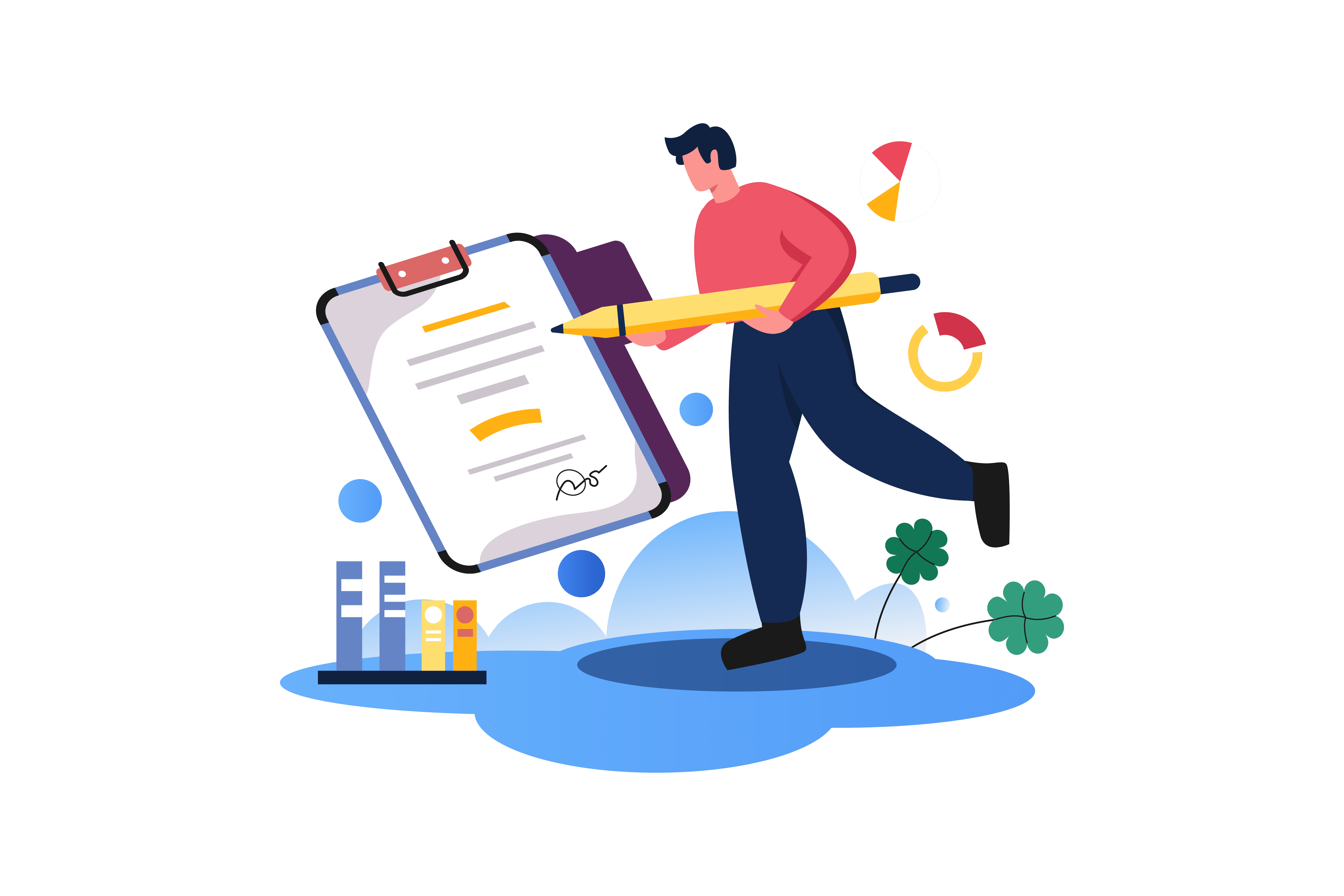
Stepping into the job market, especially as a recent graduate or an economics student, can often feel like preparing for a grand performance. Your cover letter serves as the opening act, setting the stage for your resume and job application. Did you know that an astonishing 45% of job seekers don’t send cover letters with their applications? Yet, a tailored cover letter could be your golden ticket to landing that dream job. From crafting a magnetic introduction to strategizing skill mapping and showcasing a masterful grip on company knowledge, we’re here to guide you through each nuanced step. With this blog post, you’re not just writing a cover letter; you’re orchestrating a narrative that resonates with hiring managers, portraying you as the ideal candidate they’ve been seeking. Ready to elevate your job application to an art form? Dive in to unlock the secrets to a captivating cover letter that aligns seamlessly with any job description.
Crafting a Magnetic Cover Letter Introduction
Embark on the vital journey of crafting a magnetic cover letter introduction, the first act of your job application performance.

Unveiling the Power of a Strong Opening
How does one captivate the attention of a hiring manager within the first few lines? A strong opening is your secret weapon. A potent concoction of clear articulation of your employment history and a vivid demonstration of your enthusiasm for the job position can be transformative. This initial section should not merely be an opening act but a grand entrance, setting a dynamic and inviting tone for the rest of your application. Ask yourself, does your introduction invite the hiring manager to delve deeper?
Personal Branding in the Introductory Paragraph
Personal branding is more than a buzzword; it’s your unique signature in the job market. Injecting a dose of personal branding in your introductory paragraph not only showcases your skills and qualifications but also tells a story of who you are beyond the resume. It’s about carving a space where your unique value proposition shines, urging the hiring manager to envision you as a vibrant addition to their team. How does your personal brand resonate with the company’s mission and values?
Next,let’s navigating towards crafting skill sets
Showcasing Your Stellar Skill Set
Embark on the journey to magnify your abilities right in your cover letter.

Strategic Skill Mapping
Translating your skills into a language that resonates with the hiring manager is nothing short of an art. Imagine being in a position where every aspect of your cover letter communicates that you are not just a suitable candidate but the ‘right’ one. This is what strategic skill mapping is all about. It is about aligning your unique skills seamlessly with the job descriptions, creating a harmonious melody that captures the essence of your professional journey. It’s about underlining those skills that sing in tune with the position you are eyeing, crafting a tailored content that portrays you as the protagonist in the job narrative. How well do your skills harmonize with the job position in question? Reflect on this, and begin crafting a cover letter that portrays you as the quintessential candidate.
Illustrating Skills through Achievements
In the grand theatre of job applications, your achievements are the spotlight moments that captivate your audience – the hiring managers. They are narratives woven with threads of skills and qualifications, painting a vivid picture of your journey. To craft a compelling story, you need to venture beyond merely listing your accomplishments. Dive deep, showcasing how each achievement was not just a milestone but a testament to your skills. How did your personal branding influence your achievements? Reflect on this, creating a narrative that doesn’t just list your achievements but celebrates them, inviting the hiring manager into the vibrant story of your professional journey.
Let’s journey next into tailoring content for a targeted impact.
Tailoring Content for a Targeted Impact
Embark on a journey to meticulously craft your cover letter, showcasing a deep understanding of the role and the company at hand.

Research-Driven Approach to Content Tailoring
Entering the job market demands a research-driven approach, setting a solid foundation for your cover letter. But, where to start? Begin with a deep dive into the company’s ethos, mission, and recent developments. Translate this understanding into a vivid narrative in your cover letter, positioning yourself as a well-prepared candidate who’s ready to blend seamlessly into the prospective role. This tactic not only demonstrates an awareness of the company’s direction but also fosters a robust connection with the hiring manager, potentially tipping the scales in your favor. Reflect on this: How can your employment history enrich the company’s current trajectory?
Hitting the Mark with Tailored Content
The art of tailoring content is akin to weaving a tapestry of your skills and qualifications in harmony with the job description. It requires a finesse in maintaining a consistent narrative that resonates with the job position you are aiming for. But beware, a fine balance is essential to avoid over-customization that might appear insincere. Have you considered the alignment of your personal branding with the company’s values? As you venture into writing a strong cover letter introduction, bear in mind the importance of echoing the sentiments of the job description subtly, enhancing the chances of making a memorable impression on the hiring manager.
Stay tuned for insights on integrating the company insights in our next section.
Conveying Mastery Over Company Knowledge
In a job market teeming with competition, showcasing your deep understanding of a company can set your cover letter apart. Let’s dive into how to skillfully weave this knowledge into your narrative.

Integrating Company Insights into Your Narrative
As you venture into writing a strong cover letter introduction, consider the first impression you want to make. Picture this: a cover letter that not only presents your skills and qualifications but also resonates with the company’s core values and mission. Imagine seamlessly aligning your personal branding with the firm’s ethos, creating a narrative that speaks volumes about your genuine interest in the job position. How can you make this a reality? Start by researching the company extensively. Understand their objectives, culture, and market stance. Now, weave these insights into your introductory paragraph, illustrating your deep connection with the company and painting a picture of a symbiotic relationship where both parties flourish.
Demonstrating Alignment with Company Goals
As we navigate further, the importance of aligning yourself with the company’s objectives becomes evident. How do you demonstrate that your career trajectory is in sync with the company’s growth? A well-crafted section in your cover letter could be the key. Here, bring to light instances from your employment history where you have contributed to objectives similar to those of the prospective company. Showcase how your skills and qualifications not only make you an excellent candidate but also a valuable asset ready to propel the company towards its goals. Remember, a tailored content approach will allow you to highlight your potential contributions vividly, fostering a connection with the hiring manager right from the outset.
Stay tuned for more insights on how to create a memorable closing paragraph.
Creating a Memorable Closing Paragraph
In your cover letter journey, the finale holds a pivotal role. It is here that you lay down the final strokes of your masterpiece, ensuring the hiring manager is left intrigued and eager to explore further.

Crafting a Powerful Call to Action
Sealing your cover letter with a potent call to action isn’t just an ending note; it’s an invitation, a beckoning for the reader to step into the next chapter. As you write, infuse it with confidence and a clear demonstration of your eagerness to progress to the interview stage. Consider phrases that echo a forward momentum, a mutual journey that both you and the potential employer are embarking on. And as you wrap up, perhaps pose a thoughtful question, inviting them to ponder on the mutual benefits that lie ahead. How might your unique blend of skills and qualifications bolster the team’s success?
Leaving a Lasting Impression
The final section of your cover letter needs to resonate deeply, leaving an image that lingers well after reading. This is where your personal branding takes center stage, crafting a conclusion that echoes both your qualifications and your persona. Picture your closing paragraph as an encore in a grand performance, leaving a vibrant, lasting impression that calls for further exploration. Think, how can you portray a narrative that stands as both authentic and engaging, nudging them to delve deeper into your resume and employment history?
Next, let’s pivot towards fine-tuning the cover letter you create.
Fine-Tuning with Proofreading and Editing
Enhance the potency of your cover letter by investing time in meticulous proofreading and editing. Here, we unravel the methods that elevate the quality of your document, promising a professional and error-free submission that resonates well with hiring managers.

Implementing Effective Editing Techniques
Embarking on the editing journey, one might ask, how do you sift through your draft to pinpoint areas that necessitate refinement? Employing effective editing techniques is crucial in elevating your cover letter to a professional standard. Not only does it help in aligning your narrative with the job position in focus, but it also assists in mapping out your skills and qualifications in a structured manner. By integrating tailored content, you sculpt an introductory paragraph that strikes a chord, enticing the reader to delve deeper into your personal branding narrative. Consider this: have you revisited your introduction to ensure it mirrors the job application’s tone, showcasing your understanding of the role distinctly? Reflect on this as you fine-tune your cover letter, paving the way to a compelling job application.
Proofreading for a Flawless Submission
Now that your content is honed to perfection, what next steps should you undertake to guarantee a flawless submission? Proofreading stands as your final bastion, safeguarding against grammatical errors and inconsistencies that might have slipped through. This stage calls for a meticulous approach, where each line is scrutinized to ensure coherence and professionalism. Remember, a polished document echoes your attention to detail, a trait much admired by hiring managers. As you tread this path, ponder upon this: does your cover letter portray a coherent picture of your employment history and anticipated trajectory? Utilize this reflective moment to align your narrative seamlessly, crafting a masterpiece that stands out in the competitive job market.
Before you venture into the next section, take a moment to embrace the transformation your cover letter has undergone, ready to captivate any hiring manager’s attention.
Best Practices for Emailing Your Application
Embarking on your job hunt journey necessitates acing the email application stage, a pivotal step that can set a harmonious tone for your job application. Let’s delve into the quintessential practices for a seamless application process through email.

Crafting a Professional Email Format
In a world where a staggering number of emails are sent daily, standing out to a hiring manager begins with crafting a professional email format. Start by selecting a professional email address, ideally one that incorporates your name. While drafting the email, ensure that the subject line succinctly reflects the job position you are applying for, accompanied by a salutation that echoes respect and formality. Moreover, integrate the tailored content of your cover letter in the email body, presenting a cohesive narrative that highlights your skills and qualifications, thereby creating a compelling introductory paragraph that seamlessly transitions into your resume. Do you think your current email format aligns with the professional standards sought by employers?
Ensuring Smooth Delivery of Your Application
Once the stage is set with a professional email format, the next pivotal step is ensuring the smooth delivery of your job application. It goes beyond just hitting the ‘send’ button. Begin by double-checking the recipient’s email address to avoid any errors. Subsequently, attach your resume and cover letter as PDF files to maintain formatting and structure, keeping in mind the file size restrictions. Additionally, consider sending a test email to yourself first, an effective strategy to avoid common pitfalls like broken links or formatting issues. Before pressing send, pause and reflect: have you ensured that all elements harmonize to convey a cohesive personal branding narrative?
Having meticulously prepared and sent your application, it’s time to navigate the often understated yet crucial follow-up process. Let’s dive in.
Navigating the Follow-Up Process
Embark on a seamless journey of mastering the follow-up process after sending your job application, safeguarding professionalism while displaying persistent enthusiasm for the job position.

Timing Your Follow-Up Effectively
Perfect timing can be the linchpin in securing a promising dialogue post-application. Understanding when to send a follow-up message is critical, and as someone gearing up to take significant strides in the job market, you’d want to nail this aspect. Ask yourself, have you given the hiring manager enough time to review your application? Develop strategies that cultivate a delicate equilibrium between showcasing genuine interest without appearing too eager, thus enhancing your chances of progressing further in the employment process. Remember, a well-timed follow-up reiterates your enthusiasm and reflects your keenness in bringing your skillset to the table.
Crafting a Polished Follow-Up Message
The process of creating a refined follow-up message is akin to tailoring your cover letter to a specific job; it requires a touch of personal branding. A message that echoes your professionalism and an unwavering interest in the job position can potentially stir a positive resonance with the hiring manager. Are your skills and qualifications reflected subtly in the follow-up without sounding redundant? It’s vital to convey your eagerness without overshadowing it with unnecessary information. Your message should be a gentle reminder of your application, a nudge that tells the employer – here lies a candidate whose profile aligns harmoniously with your company’s ethos, ready to make a significant contribution.
Conclusion
Stepping back into the limelight of our initial act, we remember the grand performance metaphor of the job market and the pivotal role your cover letter plays. From nailing that magnetic introduction and strategically mapping your skill set to adeptly tailoring content for a targeted impact, and impressively conveying mastery over company knowledge – it’s evident that a well-crafted cover letter is more than just an accessory to your job application. Rather, it’s an orchestrated narrative, resonating with every hiring manager’s desire to find the perfect candidate. As you, a budding economist or recent graduate, embark on your job-seeking journey, remember that knowledge, preparation, and personal branding are your steadfast allies. Armed with these insights, not only will your cover letter sing in harmony with any job description, but it will also beckon employers to witness your crescendo in person. Share this guide with peers, discuss your strategies, and let the art of crafting compelling cover letters be your standing ovation in the job market. Return for more insights, and let’s craft job application masterpieces together!
Ready to turn heads with a cover letter that speaks volumes? Get ahead with CareerSpark. Tailored prompts and intelligent content creation await to give your job applications the edge they deserve. Start your free trial now and embrace the future of personalized job applications.
